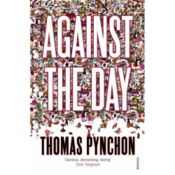Pagination Blues
Thanks to Dr. Basileios Drolias, proprietor of the Against the Day blog for this info.
I suppose worst-case scenario is that readers who want to take full advantage of this wiki will have to get themselves the original hardback or one of the many contributors will devise a page-conversion equation.
WikiAdmin 08:01, 7 October 2007 (PDT)
The UK Paperback Pagination
Basileios Drolias has sent along the differences in pagination between the UK and USA hardback editions and the forthcoming UK paperback. The first entry is the hardback edition; the second is the UK paperback edition. He also includes a first pass estimated formula for converting page numbers:
- Part 1 page 1 | page 1
- Part 2 page 119 | page 133
- Part 3 page 429 | page 483
- Part 4 page 695 | page 781
- Part 5 page 1063 | page 1195
- last page: page 1085 | page 1220
- The best factor for translating from one page to the other seems to be close to 1.1237. Still not 100% accurate.
WikiAdmin 07:11, 9 October 2007 (PDT)
Random House UK Explains
I emailed Random House UK Marketing's Tom Avery, asking why they changed the pagination for the paperback edition. His reply:
- I’m afraid the decision to alter the pagination was made from a practical perspective – as we are publishing in B format, retaining the same page size would render the text microscopic.
FYI: "Paperback (B format)" means that the size of the book is 198mm x 129mm (7.8" x 5"). You may also see paperback editions of books advertised as "A format." This means that the size of the book is 178mm x 110mm (7" x 4.3").
Interestingly, both the Penguin and Jonathan Cape (Random House UK) ARCs of Against the Day were printed in "C format" (235mm x 153mm / 9.25" x 6") aka "Royal Octavo."
WikiAdmin 08:18, 11 October 2007 (PDT)
Further Discussion
Well, let's stop blaming Penguin before we actually have the paperback in our hands. Based on the evidence so far, I do belive that the US paperback will have the same pagination as the first edition: Amazon as well as Penguin's own website state that the paperback runs to 1104 pages. In all likelihood, this page count shouldn't be regarded as the number of numbered pages, but as the total number of pages in the book. Thus, many websites originally listed the page count of the first edition at 1104 pages, and if you include the unnumbered pages of the front and back matter of the first edition, it does in fact run to 1104 pages.
This doesn't necessarily mean, of course, that the US paperback will end up with the stated number of pages. The stated page count of the first edition changed back and forth a number of times in the months leading up to publication, and the page count of the US paperback can still be changed. If it stays at 1104 pages, though, I think it likely that this translates into 1085 numbered pages.
I've also got my hands on a copy of the UK paperback, and it is correct that this edition has a different page count. Amazon.co.uk lists the page count as 1234 pages, but the actual number of numbered pages is 1220 (again, note the difference between the total number of pages and the numbered pages). The good news is that most of the many typos from the first edition have been corrected in this edition. The bad news is that the print is vanishingly small - practically unreadable - and, of course, that the page count differs from the first edition.
So let's hope that the page count of the US paperback remains at 1104/1085, and that the many errors have been corrected here as well. Then we would have a decent standard text from which to proceed.
Torerye 00:48, 9 October 2007 (PDT)
UPDATE: I've also managed to get my hands on a copy of the US paperback, and I can confirm that it has the same pagination as the first edition (1085 numbered pages). Most of the many errors from the first edition have been corrected in the Penguin paperback, so for scholarly (and our) purposes, the text in the paperback should supplant the first edition as the new standard text. Furthermore, the type in the US paperback is surprisingly readable. I had feared that the reduction of the page size would make the type size uncomfortably small, but by reducing the size of the margin, Penguin has managed to retain a very readable type size (as opposed to the minuscule print in the UK paperback). So kudos to Penguin for a nice job, both with regard to the text and the wonderfully dynamic cover.
Torerye 04:30, 22 October 2007 (PDT)
Pagination is determined by type size, font and page set-up as well as the height and width size of the book. Given those choices, the pagination of the book becomes mathematical.
And, although I do not believe in buying 'used' books for authors I would like to get whatever not-usually-enough royalties they deserve, there are many 'used' hardcover AtDs available very cheap.
[Buy new for Jackson is my motto] MKOHUT 17:23, 21 October 2007 (PDT)
Re: publishing formats:
Although I am not fully familiar with American book production lingo, in my time in publishing, I never heard paperback formats referred to as A-B-C, etc. A-and there seem to be more size possibilities in American houses, sizes referred to in inches, of course; most common sizes being 5.5 x 8.5 and 6 x 9.

